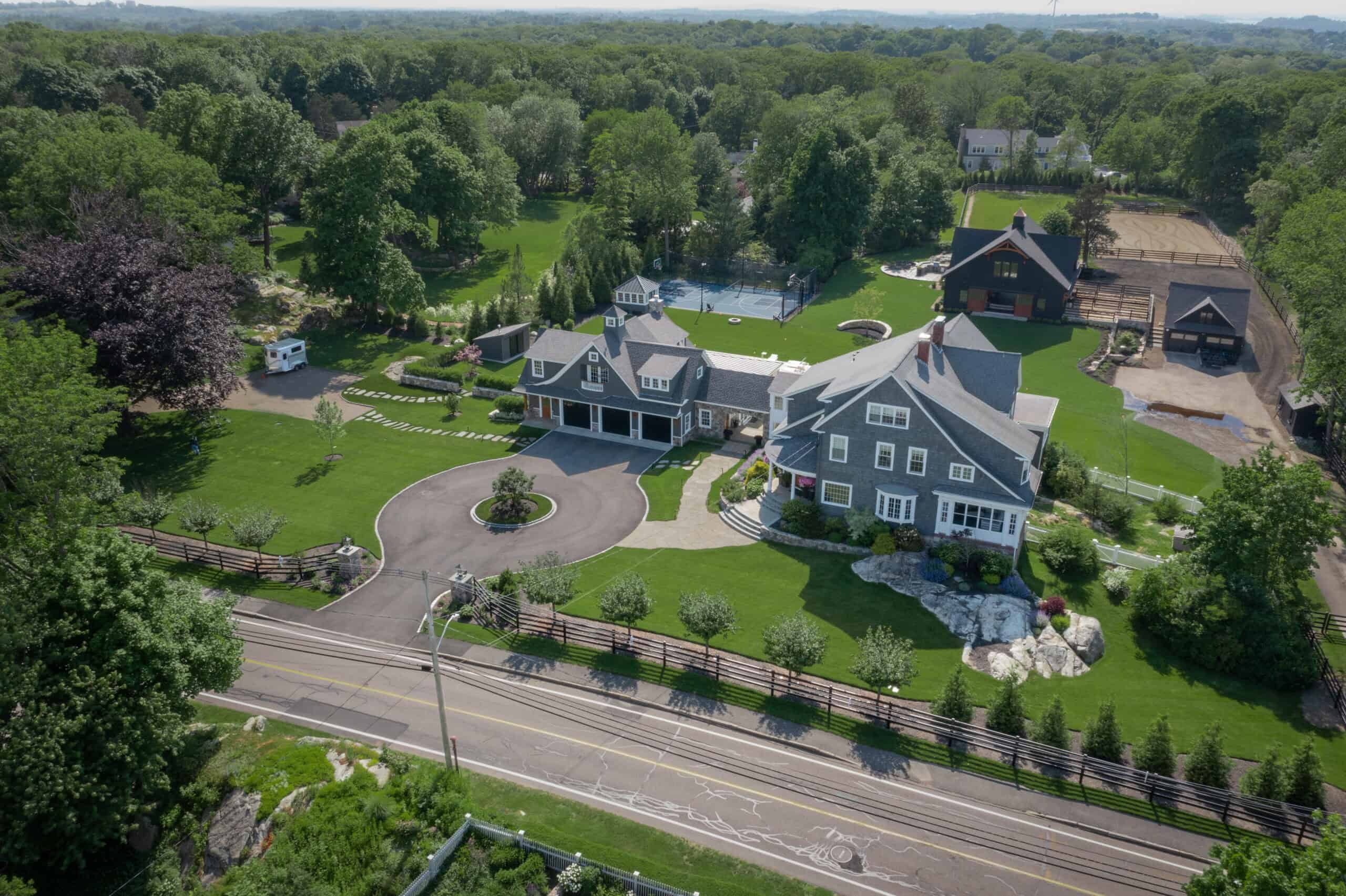There’s a world of difference between a ranch that works and one that fights you every day. Walk onto a properly planned property, and everything makes sense. The barn’s where it should be, fencing flows with the land, and the owner works animals instead of constantly fixing problems.
Then there’s the other kind: where somebody just started building wherever seemed convenient that morning. The barn’s in the wrong spot, roads flood every spring, and you’re always walking twice as far as you should for daily chores.
The difference isn’t luck or money. It’s planning. Poor ranch design costs you for decades in wasted steps, constant repairs, and problems that proper planning would’ve prevented entirely.
Smart ranch design isn’t complicated, though. Know your land, design for efficiency, build for the long haul, and never compromise on infrastructure.
Get it right from the start, and your ranch works for you. Get it wrong, and you’ll spend years fighting battles you never should’ve had to fight.
1. Ranch Planning: Know Your Land Before You Plan
You can’t design a ranch until you understand what you’re working with. Too many folks get excited about their vision and start placing buildings on paper before they’ve spent a single day really studying their property.
Site Analysis
Topography and drainage patterns matter more than anything else on your property. Water always wins, and it’s going to go where it wants regardless of your plans. Walk your land during a hard rain and see where water flows, where it pools, and where it cuts new channels. Those wet spots in spring are where you don’t put your barn. Those natural high points with good drainage are where your buildings want to be.
Soil types and load-bearing capacity determine what you can build and where. Clay soils shift and settle, sandy soils drain but may not support heavy structures, and rocky ground might fight your post-hole digger but provide excellent foundations. Get a soil survey or hire someone who knows dirt (it’ll save you from watching buildings settle or crack later).
Existing water sources and seasonal variations are your lifeline. Wells, springs, creeks, and ponds all come with their own advantages and limitations. That creek that looks permanent in spring might be bone dry by August. Plan your water system around the worst-case scenario, not the best.
Wind patterns and weather considerations affect everything from barn ventilation to where you pile manure. Prevailing winds should blow away from your house, not toward it. Know where snow drifts pile up, where ice forms first, and which areas stay muddy longest.
Define Your Ranch Purpose
Cattle vs. horses vs. mixed operations have completely different infrastructure needs. Cattle need smart handling facilities and large pastures. Horses need more secure fencing and closer monitoring. Mixed operations need the flexibility to adapt areas for different uses. Know what you’re raising before you start building for it.
Commercial vs. lifestyle ranch planning determines everything from road capacity to facility sizing. Commercial operations need equipment access and loading docks. Lifestyle ranches can prioritize aesthetics and convenience. Both need to be profitable, but the math works differently.
Current needs vs. 10-year vision should align from day one. Build infrastructure that serves today but adapts for tomorrow. That means sizing utilities for future expansion and planning roads that can handle growth.
Your land will tell you where everything should go. You just need to take the time to listen.
2. The Hub-and-Spoke Ranch Layout Strategy
The smartest ranch layouts work like wheel spokes radiating out from a central hub. Everything connects back to your headquarters: the nerve center where you live, work, and make decisions. Get this foundation right, and every day runs smoother.
Central Operations Philosophy
Place your headquarters at the center of your daily operations, not at the edge of your property.
Your house, main barn, and primary work areas should form a tight cluster within easy walking distance. When you can step out your back door and be at the barn in two minutes, you’ll check on animals more often, catch problems earlier, and handle emergencies faster.
Design every layout decision around minimizing daily travel time. The average rancher walks several miles just doing morning chores. Cut those distances in half, and you’ve bought yourself an extra hour every day (seriously), and that’s time you can spend on the work that actually matters.
Plan for efficiency in your daily routines:
- Feed storage within 100 yards of feeding areas
- Tool storage where you actually use the tools
- Equipment parking near the work areas
Zoning Your Property
- Core Zone (Headquarters): Your main barn belongs within 200 yards of your house. Close enough for easy monitoring but far enough to minimize noise and odors. Equipment storage and shop areas cluster around the barn where you’ll actually use them. Feed storage gets truck access but stays protected from weather. Office space integrates with your operations, not isolated in the house where it’s forgotten.
- Production Zones: Grazing areas spread out from the core in manageable sections sized for your operation. Breeding and calving grounds need shelter access but stay separate from high-traffic areas. Quarantine facilities sit isolated enough to prevent disease spread but accessible enough for daily care. Crop and hay fields position themselves for smart equipment movement.
- Support Zones: Handling facilities located near loading areas where trucks and trailers can maneuver safely. Waste management areas stay downwind and downhill from everything else but remain accessible for equipment. Visitor parking and guest areas separate from daily operations (nobody wants to navigate around a working ranch just to visit).
The hub-and-spoke approach is all about creating a ranch that functions like a business instead of a scattered collection of buildings that happen to share the same property lines. When everything connects logically to a central point, your ranch works with you instead of against you.
3. Infrastructure Placement That (Actually) Works
Most ranchers treat building placement like a game of property Tetris—you know, finding spots where things fit instead of where they should go. But smart infrastructure placement follows rules that’ve been proven by generations of successful operations.
Building Placement Fundamentals
Position your main barn upwind from your house to keep odors and dust from drifting toward living areas. Nobody wants to smell the barn every time they open a window.
Place it on a slight elevation so water drains away from the structure naturally. Standing water around the barns creates mud, disease problems, and foundation issues.
Orient buildings for southern exposure in northern climates. Winter sun keeps things warmer, summer breezes provide natural ventilation, and you’ll use less energy year-round. Plan road access that accommodates feed trucks, equipment haulers, and emergency vehicles without tight turns or soft ground that’ll trap heavy trucks.
Utility Systems Done Right
Wells belong uphill from barns, septic systems, and any potential contamination sources. Gravity’s your friend here. Use it. Bury distribution lines below frost line, or you’ll spend winter mornings thawing frozen pipes instead of feeding animals.
Install automatic waterers in every pasture where animals spend time. Hand-carrying water buckets twice daily gets old fast, and consistent water access keeps animals healthier and more productive. Design backup systems for drought or equipment failure—when the primary system fails, you need solutions, not emergencies.
Size your main electrical service for 150% of current needs. Adding capacity later costs a lot more than planning ahead. Run 220V service to barns for equipment, welders, and high-demand tools. Put outdoor lighting on separate circuits so you can light work areas without powering everything.
Plan emergency generator hookups from the start. When storms knock out power, your animals still need water pumps, ventilation fans, and milking equipment running.
Fencing: The Foundation of Everything
Steel board fencing for main boundaries provides permanent, attractive containment that won’t embarrass you when neighbors or visitors drive by. Unlike wood that rots, warps, and requires constant maintenance, steel systems last decades with minimal upkeep.
Position gates for access and emergency evacuation routes. Fire trucks, ambulances, and equipment haulers need space to maneuver—design for the worst-case scenario, not just daily convenience.
Design rotational grazing paddocks with consistent water access in every section. Animals won’t use pastures without reliable water sources, and hand-watering defeats the purpose of rotational systems.
Flexible steel fencing systems adapt as your operation changes without major reconstruction. When you need to reconfigure pastures, expand facilities, or change livestock types, quality fencing moves with you.
Plan ranch fence lines that integrate with handling facilities and create logical livestock flow patterns. Animals should move naturally from pasture to working areas without complex routing or excessive gates.
4. How to Future-Proof Your Investment
Ranch planning isn’t just about today’s needs—it’s about building something that adapts, grows, and stays valuable for decades. The ranchers who get this right spend their time managing operations instead of constantly rebuilding them.
Design for Adaptability
Modular building systems expand easily when your operation grows or changes direction. Design barns with removable walls, plan foundations that extend logically, and choose roof systems that add sections without major reconstruction. What starts as a small horse barn might need to become a breeding facility, equipment storage, or completely different operation down the road.
Electrical panels, water systems, and septic capacity that seem adequate today will feel cramped when you expand. Running new main lines later costs much more than planning ahead during initial installation.
Choose fencing systems that relocate without major reconstruction. Steel board fencing adapts to changing pasture configurations, facility expansions, and operational shifts without losing integrity or appearance. Wood fencing that looked permanent becomes an expensive obstacle when you need flexibility.
Build road systems for heavy equipment access, even if you’re currently running a small operation. Future buyers, emergency vehicles, and expansion projects all need proper access. Narrow roads and weak bridges become expensive bottlenecks when your needs outgrow your infrastructure.
Long-Term Value Considerations
Quality materials pay for themselves through reduced maintenance and longer service life. Steel fencing might cost more upfront than wood, but it removes decades of painting, board replacement, and weather damage.
Calculate lifetime costs, not just initial expenses.
Design drainage systems that prevent future problems instead of just handling current runoff. Climate patterns change, development upstream affects your water flow, and poorly planned drainage becomes more expensive to fix every year you wait.
Energy-efficient designs reduce operating costs permanently. Proper building orientation, insulation choices, and natural ventilation systems cut utility bills for the life of the structure. What seems like minor savings annually becomes major over decades.
Consider market appeal for eventual resale or expansion financing. Well-planned ranches with quality infrastructure attract buyers and command premium prices. Poor planning limits your options and reduces property values when circumstances change.
Plan for technology integration and upgrade pathways. Modern ranch management increasingly depends on automated systems, monitoring equipment, and data collection. Design facilities with conduit space, power capacity, and access for future technology additions.
Plan Smart, Build Once
Every shortcut you take today becomes a problem you’ll fight for the next thirty years. Every quality choice you make becomes an advantage that pays dividends for decades.
Smart ranchers do it different. They invest in steel board fencing that stands strong through decades of weather, horse testing, and operational changes. They plan infrastructure that adapts to growth instead of fighting it. They build once, build right, and spend their time managing operations instead of constantly fixing problems.
Steel fencing isn’t just about containment: it’s about smart ranch planning. When your boundaries maintain their integrity regardless of what animals or weather throw at them, everything else functions better.
Your ranch deserves infrastructure that works as hard as you do. Let’s make sure that’s exactly what you get.



